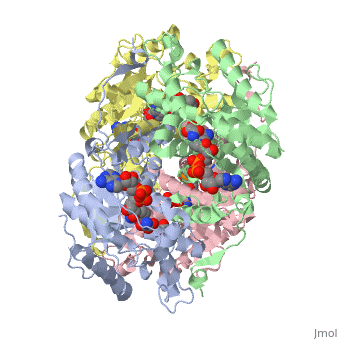1i10: Difference between revisions
New page: left|200px<br /> <applet load="1i10" size="450" color="white" frame="true" align="right" spinBox="true" caption="1i10, resolution 2.3Å" /> '''HUMAN MUSCLE L-LACTA... |
No edit summary |
||
| Line 1: | Line 1: | ||
[[Image:1i10.gif|left|200px]]<br /> | [[Image:1i10.gif|left|200px]]<br /><applet load="1i10" size="350" color="white" frame="true" align="right" spinBox="true" | ||
<applet load="1i10" size=" | |||
caption="1i10, resolution 2.3Å" /> | caption="1i10, resolution 2.3Å" /> | ||
'''HUMAN MUSCLE L-LACTATE DEHYDROGENASE M CHAIN, TERNARY COMPLEX WITH NADH AND OXAMATE'''<br /> | '''HUMAN MUSCLE L-LACTATE DEHYDROGENASE M CHAIN, TERNARY COMPLEX WITH NADH AND OXAMATE'''<br /> | ||
==Overview== | ==Overview== | ||
Lactate dehydrogenase (LDH) interconverts pyruvate and lactate with | Lactate dehydrogenase (LDH) interconverts pyruvate and lactate with concomitant interconversion of NADH and NAD(+). Although crystal structures of a variety of LDH have previously been described, a notable absence has been any of the three known human forms of this glycolytic enzyme. We have now determined the crystal structures of two isoforms of human LDH-the M form, predominantly found in muscle; and the H form, found mainly in cardiac muscle. Both structures have been crystallized as ternary complexes in the presence of the NADH cofactor and oxamate, a substrate-like inhibitor. Although each of these isoforms has different kinetic properties, the domain structure, subunit association, and active-site regions are indistinguishable between the two structures. The pK(a) that governs the K(M) for pyruvate for the two isozymes is found to differ by about 0.94 pH units, consistent with variation in pK(a) of the active-site histidine. The close similarity of these crystal structures suggests the distinctive activity of these enzyme isoforms is likely to result directly from variation of charged surface residues peripheral to the active site, a hypothesis supported by electrostatic calculations based on each structure. Proteins 2001;43:175-185. | ||
==Disease== | ==Disease== | ||
| Line 11: | Line 10: | ||
==About this Structure== | ==About this Structure== | ||
1I10 is a [http://en.wikipedia.org/wiki/Single_protein Single protein] structure of sequence from [http://en.wikipedia.org/wiki/Homo_sapiens Homo sapiens] with ACT, NAI and OXM as [http://en.wikipedia.org/wiki/ligands ligands]. Active as [http://en.wikipedia.org/wiki/L-lactate_dehydrogenase L-lactate dehydrogenase], with EC number [http://www.brenda-enzymes.info/php/result_flat.php4?ecno=1.1.1.27 1.1.1.27] Full crystallographic information is available from [http:// | 1I10 is a [http://en.wikipedia.org/wiki/Single_protein Single protein] structure of sequence from [http://en.wikipedia.org/wiki/Homo_sapiens Homo sapiens] with <scene name='pdbligand=ACT:'>ACT</scene>, <scene name='pdbligand=NAI:'>NAI</scene> and <scene name='pdbligand=OXM:'>OXM</scene> as [http://en.wikipedia.org/wiki/ligands ligands]. Active as [http://en.wikipedia.org/wiki/L-lactate_dehydrogenase L-lactate dehydrogenase], with EC number [http://www.brenda-enzymes.info/php/result_flat.php4?ecno=1.1.1.27 1.1.1.27] Full crystallographic information is available from [http://oca.weizmann.ac.il/oca-bin/ocashort?id=1I10 OCA]. | ||
==Reference== | ==Reference== | ||
| Line 18: | Line 17: | ||
[[Category: L-lactate dehydrogenase]] | [[Category: L-lactate dehydrogenase]] | ||
[[Category: Single protein]] | [[Category: Single protein]] | ||
[[Category: Brady, R | [[Category: Brady, R L.]] | ||
[[Category: Eszes, C | [[Category: Eszes, C M.]] | ||
[[Category: Read, J | [[Category: Read, J A.]] | ||
[[Category: Sessions, R | [[Category: Sessions, R B.]] | ||
[[Category: Winter, V | [[Category: Winter, V J.]] | ||
[[Category: ACT]] | [[Category: ACT]] | ||
[[Category: NAI]] | [[Category: NAI]] | ||
| Line 29: | Line 28: | ||
[[Category: rossman fold]] | [[Category: rossman fold]] | ||
''Page seeded by [http:// | ''Page seeded by [http://oca.weizmann.ac.il/oca OCA ] on Thu Feb 21 13:06:53 2008'' | ||
Revision as of 14:06, 21 February 2008
|
HUMAN MUSCLE L-LACTATE DEHYDROGENASE M CHAIN, TERNARY COMPLEX WITH NADH AND OXAMATE
OverviewOverview
Lactate dehydrogenase (LDH) interconverts pyruvate and lactate with concomitant interconversion of NADH and NAD(+). Although crystal structures of a variety of LDH have previously been described, a notable absence has been any of the three known human forms of this glycolytic enzyme. We have now determined the crystal structures of two isoforms of human LDH-the M form, predominantly found in muscle; and the H form, found mainly in cardiac muscle. Both structures have been crystallized as ternary complexes in the presence of the NADH cofactor and oxamate, a substrate-like inhibitor. Although each of these isoforms has different kinetic properties, the domain structure, subunit association, and active-site regions are indistinguishable between the two structures. The pK(a) that governs the K(M) for pyruvate for the two isozymes is found to differ by about 0.94 pH units, consistent with variation in pK(a) of the active-site histidine. The close similarity of these crystal structures suggests the distinctive activity of these enzyme isoforms is likely to result directly from variation of charged surface residues peripheral to the active site, a hypothesis supported by electrostatic calculations based on each structure. Proteins 2001;43:175-185.
DiseaseDisease
Known disease associated with this structure: Exertional myoglobinuria due to deficiency of LDH-A OMIM:[150000]
About this StructureAbout this Structure
1I10 is a Single protein structure of sequence from Homo sapiens with , and as ligands. Active as L-lactate dehydrogenase, with EC number 1.1.1.27 Full crystallographic information is available from OCA.
ReferenceReference
Structural basis for altered activity of M- and H-isozyme forms of human lactate dehydrogenase., Read JA, Winter VJ, Eszes CM, Sessions RB, Brady RL, Proteins. 2001 May 1;43(2):175-85. PMID:11276087
Page seeded by OCA on Thu Feb 21 13:06:53 2008
